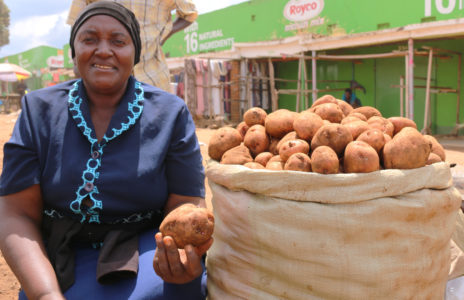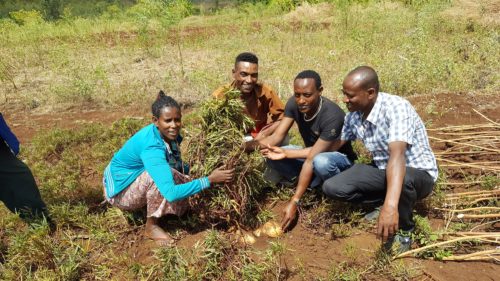
Sweetpotato, particularly orange-fleshed varieties, has under-exploited potential to improve nutrition and help build resilience to climate change among poor farming families across India. This project, which aims to improve food security, nutrition, and livelihoods in Odisha state, was first implemented in 2013 and has now moved to phase II.
Background
Despite efforts by Indian scientists and policymakers, production of food crops like cereals and pulses has not kept pace with demand. Falling yields associated with severe weather and climate change, coupled with continued population growth, are widening the food security gap. Poor communities are in urgent need of alternative staples, and root crops like sweetpotato are ideally placed to provide nutritious energy at an affordable price, so long as the current low levels of productivity can be improved.
Farmers in Odisha already grow sweetpotato for fresh food and animal fodder, as well as for processing into flour, juice and other edible products. The roots can produce more edible energy per hectare than wheat, rice or cassava, and contain a rich source of vitamin A and other micronutrients essential to health, especially for women and young children.
The ‘Generating advances in incomes and nutrition through sweetpotato’ (GAINS) project began in 2013 with the first large-scale introduction of orange-fleshed sweetpotato to Odisha farmers. Six years later, the Odisha government is now considering adding these crops to the state contingency plan as key to building resilience against climate change (particularly drought) and providing disaster relief following severe storms. GAINS phase II (2018–2021) will build on the initial successes and scale up activities to communities in additional districts, including disadvantaged indigenous tribal groups.
Objectives
Phase I provided adapted and nutritious varieties of sweetpotato, together with improved cultivation techniques, to poor farmers in selected districts of Odisha, helping improve their food security, nutrition and livelihoods. Phase II will be implemented in four additional districts, with the aim of creating two major sweetpotato production zones. Phase II seeks to: a) enhance farmer access to improved sweetpotato varieties and cultivation technologies; b) develop community-based seed systems for self-sufficiency in planting materials; c) establish and strengthen sweetpotato value chains; and d) develop and implement nutrition improvement strategies.
Approach
The project targets traditional sweetpotato areas with a high incidence of poverty, malnutrition and resourceconstrained agriculture, particularly communities highlighted in the Odisha state tribal development program. The project is built around four main components:
- Introduction of selected varieties to enhance farmer access to superior planting materials. The varieties that performed well in phase I are being rolled out to additional districts.
- Improvement of local seed systems by setting up farmer field nurseries, with farmers learning about rapid multiplication and being expected to ‘pay back’ planting materials in cash or in kind.
- Identification of market opportunities and support for business development.
- Improvement food-based nutrition knowledge, such as education and promotion through schools and government institutions.
Phase I achievements
The project introduced orange-fleshed sweetpotato, Bidhan Jyoti, for the first time and organized multiplication of planting materials by local institutions and farmer groups. Farmers learned how to multiply their stocks and use innovative technologies, including mechanization, to improve their yields. Overall, the sweetpotato production area increased by more than 25% in the target districts to occupy 1,325 hectares, with productivity gains of up to 17% recorded. Promotion in schools also helped increase consumption of sweetpotato and hence improved the nutritional status of children.
Phase II expected outcomes
Phase II builds on the lessons learned to introduce new varieties and increase the orange-fleshed sweetpotato production area and productivity levels. Progressive farmers will be encouraged to establish multiplication nurseries. Different uses of sweetpotato will be showcased and facilities established to facilitate marketing, with new processing technologies made available to interested entrepreneurs. Public messaging and campaigns in schools will improve awareness of the nutritional benefits and raise the demand among consumers.
Phase II also addresses some earlier issues. For example, it will forge better links between research and extension and adopt a more scientific approach to training farmers, considering their generally low levels of education. New approaches, such as introducing sweetpotato into aquaculture systems, will be explored, as will contract farming opportunities linking growers with existing food processing industries. Partnership activities, involving the Odisha health department for example, will exploit advocacy opportunities to influence policy change in support of sustainable sweetpotato production, income generation and environmental protection.
Key outcomes
| Outcome | Target |
| Farmers trained on sweetpotato production and use | 3,000 |
| Proportion of farmers in target districts with access to improved varieties | 40% |
| Increase in contribution of sweetpotato to household income | 50% |
| Women and children receiving adequate micronutrients through sweetpotato | 1,500 |
| Farmer groups formed to exploit value-addition opportunities | 20 |
Contact
Samarendu Mohanty
CIP, India
s.mohanty@cgiar.org
Thanks to our donors



